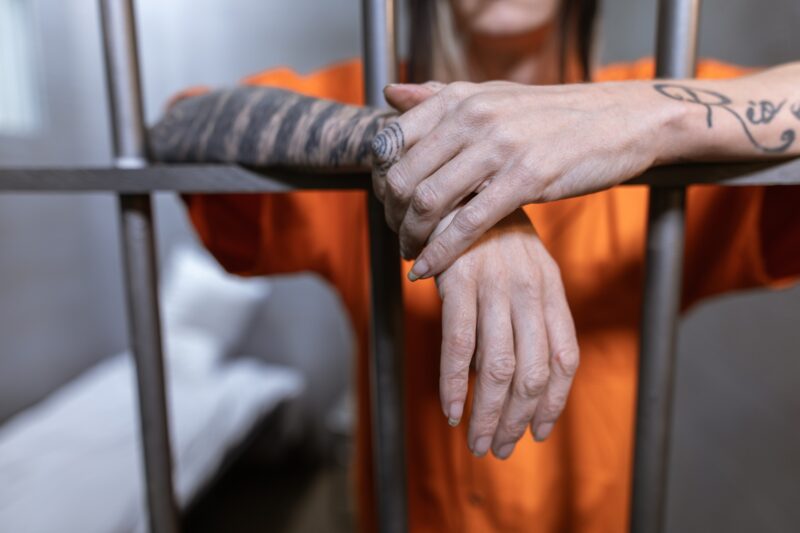
The Popularity of Prison Tattoos & the Path to Employment After Release
In the United States, recidivism– the rate at which a former inmate might re-offend or commit another crime and end up back in prison– is considered a significant challenge in the criminal justice system, with 68% of released prisoners being rearrested within three years of their release. The opposite of recidivism, desistance, is when a former inmate does not re-offend and remains out of prison.
Desistance largely depends on internal and external factors, including personal motivation, social support, education, employment, access to resources, and opportunities. The rate at which a former inmate receives work or social support after incarceration can be greatly impacted by the presence of tattoos; specifically, tattoos applied during incarceration, or tattoos on the hands, neck, or face. We’re taking a look at the factors that can impact a person’s decision to get a prison tattoo, and the options the person might have once left prison.
Reasons Why Inmates Get Tattoos

There are many reasons an inmate might receive a tattoo while in prison. The most common reasons include:
1. Identity:
In prison, tattoos can serve as a way for individuals to establish a sense of identity or belonging in a group or gang. Prison tattoos are sometimes used to signify membership, rank, or affiliation with a particular group.
2. Protection:
For some individuals, getting a tattoo can serve as a way to protect themselves from potential harm. Inmates can feel pressured to get tattoos in order to associate with a particular gang or group in an attempt to protect themselves while incarcerated. These tattoos can send a message to other inmates that the individual is not to be messed with.
3. Remembrance:
Prison tattoos can also serve as a way for individuals to commemorate important events or people in their lives. For example, an inmate may get a tattoo to honor a family member or friend who has passed away.
4. Boredom:
In some cases, inmates may get tattoos simply out of boredom. Due to a lack of activities and distractions in prison, getting a tattoo can be a way to pass the time.
It’s difficult to determine the exact number of inmates with prison tattoos, but research suggests that inmates are more likely to have tattoos than the general population. Unfortunately, this can have negative consequences outside of prison, since prison tattoos may be associated with criminal activity, even if they are just a method for survival when in prison. This can make it difficult for former inmates to reintegrate into society after their release, specifically when it comes to finding a job to get back on their feet.
Why Inmates Want Prison Tattoos Removed Upon Their Release
Reintegrating into society after incarceration can come with many challenges. A former inmate may struggle to find work, a place to live/homelessness, potential addiction challenges, and a general ability to adjust to everyday life. Challenges in overcoming these factors increase the rate of recidivism, as well as general social biases against former inmates. Prison tattoos, especially tattoos on the hands, neck, or face, or gang-affiliated tattoos, can decrease the social acceptance of a former inmate, making it harder for them to find work or a community willing to accept them.
Removing prison tattoos can help an inmate adjust to life outside of prison in a less jarring way. One study by Kaitlyn Harger suggests that visible tattoos have a significant effect on employability, and even the ability to maintain an income (particularly for former inmates), which can play a huge role in recidivism. Fortunately, prison tattoos are often easier to remove than professionally applied tattoos.
How Prison Tattoos are Applied

Prison tattoos can be smaller than professionally applied tattoos, particularly if they are gang-related or small symbols, compared to say a large professionally done back piece due to resources. This can make it easier to remove with Tatt2Away®. Prison tattoos are often applied to materials that can be found around a prison.
The tattoo “ink” is often made up of soot from burned plastic or other materials, pen ink, boot polish, or other darker materials found around a correctional facility. Application may be done by using needles an inmate has found or made from materials available around the prison, such as sharpened paperclips, guitar strings, or disposable razors.
When removing these tattoos, particularly with laser tattoo removal, there is some amount of uncertainty in the results. Laser tattoo removal pushes ink through the lymphatic system to be processed at a later time. This could potentially be harmful to the body. With Tatt2Away, ink is lifted up and out of the body through scabs, which could be safer than laser tattoo removal.
Learn more about Tatt2Away vs Laser Tattoo Removal
Developments in Prison Tattoo Removal with Tatt2Away
At Tatt2Away we like to partner with correctional facilities and prisons, such as the Utah Department of Corrections to help inmates remove gang-affiliated tattoos and visible tattoos that might impede an inmate’s ability to get a job after their release.
We are dedicated to helping formerly incarcerated individuals ease back into society. Learn more about the tattoo removal process for formerly incarcerated people here. Make sure to check out our before and after results as well.
